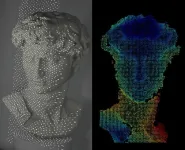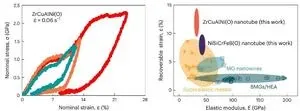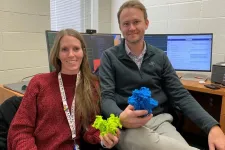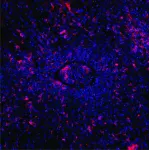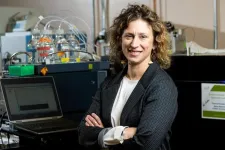A sleeker facial recognition technology tested on Michelangelo’s David
2024-02-02
(Press-News.org) Many people are familiar with facial recognition systems that unlock smartphones and game systems or allow access to our bank accounts online. But the current technology can require boxy projectors and lenses. Now, researchers report in ACS’ Nano Letters a sleeker 3D surface imaging system with flatter, simplified optics. In proof-of-concept demonstrations, the new system recognized the face of Michelangelo’s David just as well as an existing smartphone system.
3D surface imaging is a common tool used in smartphone facial recognition, as well as in computer vision and autonomous driving. These systems typically consist of a dot projector that contains multiple components: a laser, lenses, a light guide and a diffractive optical element (DOE). The DOE is a special kind of lens that breaks the laser beam into an array of about 32,000 infrared dots. So, when a person looks at a locked screen, the facial recognition system projects an array of dots onto most of their face, and the device’s camera reads the pattern created to confirm the identity. However, dot projector systems are relatively large for small devices such as smartphones. So, Yu-Heng Hong, Hao-Chung Kuo, Yao-Wei Huang and colleagues set out to develop a more compact facial recognition system that would be nearly flat and require less energy to operate.
To do this, the researchers replaced a traditional dot projector with a low-power laser and a flat gallium arsenide surface, significantly reducing the imaging device’s size and power consumption. They etched the top of this thin metallic surface with a nanopillar pattern, which creates a metasurface that scatters light as it passes through the material. In this prototype, the low-powered laser light scatters into 45,700 infrared dots that are projected onto an object or face positioned in front of the light source. Like the dot projector system, the new system incorporates a camera to read the patterns that the infrared dots created.
In tests of the prototype, the system accurately identified a 3D replica of Michelangelo’s David by comparing the infrared dot patterns to online photos of the famous statue. Notably, it accomplished this using five to 10 times less power and on a platform with a surface area about 230 times smaller than a common dot-projector system. The researchers say their prototype demonstrates the usefulness of metasurfaces for effective small-scale low-power imaging solutions for facial recognition, robotics and extended reality.
The authors acknowledge funding from Hon Hai Precision Industry, the National Science and Technology Council in Taiwan, and the Ministry of Education in Taiwan.
###
The American Chemical Society (ACS) is a nonprofit organization chartered by the U.S. Congress. ACS’ mission is to advance the broader chemistry enterprise and its practitioners for the benefit of Earth and all its people. The Society is a global leader in promoting excellence in science education and providing access to chemistry-related information and research through its multiple research solutions, peer-reviewed journals, scientific conferences, eBooks and weekly news periodical Chemical & Engineering News. ACS journals are among the most cited, most trusted and most read within the scientific literature; however, ACS itself does not conduct chemical research. As a leader in scientific information solutions, its CAS division partners with global innovators to accelerate breakthroughs by curating, connecting and analyzing the world’s scientific knowledge. ACS’ main offices are in Washington, D.C., and Columbus, Ohio.
To automatically receive news releases from the American Chemical Society, contact newsroom@acs.org.
Note: ACS does not conduct research, but publishes and publicizes peer-reviewed scientific studies.
Follow us: Twitter | Facebook | LinkedIn | Instagram
END
ELSE PRESS RELEASES FROM THIS DATE:
2024-02-02
Many complex systems, from microbial communities to mussel beds to drylands, display striking self-organized clusters. According to theoretical models, these groupings play an important role in how an ecosystem works and its ability to respond to environmental changes. A new paper in PNAS focused on the spatial patterns found in drylands offers important empirical evidence validating the models.
Drylands make up 40 percent of the Earth’s landmass and are places where water is the limiting resource for life. They often display a characteristic ...
2024-02-02
DURHAM, N.C. – As the HIV virus glides up outside a human cell to dock and possibly inject its deadly cargo of genetic code, there’s a spectacularly brief moment in which a tiny piece of its surface snaps open to begin the process of infection.
Seeing that structure snap open and shut in mere millionths of a second is giving Duke Human Vaccine Institute (DHVI) investigators a new handle on the surface of the virus that could lead to broadly neutralizing antibodies for an AIDS vaccine. Their findings appear Feb. 2 in Science Advances.
Being able to attach an antibody specifically to ...
2024-02-02
Some hereditary genetic defects cause an exaggerated immune response that can be fatal. Using the CRISPR-Cas9 gene-editing tool, such defects can be corrected, thus normalizing the immune response, as researchers led by Klaus Rajewsky from the Max Delbrück Center now report in “Science Immunology.”
Familial hemophagocytic lymphohistiocytosis (FHL) is a rare disease of the immune system that usually occurs in infants and young children under the age of 18 months. The condition is severe and has a high mortality rate. It is caused by various gene mutations that prevent cytotoxic T cells from functioning normally. These ...
2024-02-02
BIRMINGHAM, Ala. – Cigarette smoke exposure is associated with the development and severity of chronic obstructive pulmonary disease, or COPD, which is the third leading cause of death worldwide.
Cigarette smoke contains 2 to 3 micrograms of cadmium, a highly toxic metal and environmental pollutant, per cigarette. Burning tobacco releases cadmium oxide that can be adsorbed onto microparticles in smoke that travel deep into the lungs. Furthermore, the body is not able to remove cadmium, which accumulates in longtime smokers.
In ...
2024-02-02
First-of-its-kind research on cryptocurrency finds that the most regulated coins create the most efficient markets.
That crypto regulation, often provided by cryptocurrency exchanges like Binance, can also help protect investors by providing reliable, public information.
“Both small and institutional investors should know, if they invest in coins without any regulation, they may suffer from price manipulation or a severe lack of insider information,” said Liangfei Qiu, a University of Florida professor of business and one of the authors of the new study.
“Instead, they may want to invest in coins listed with platforms ...
2024-02-02
The ancient astronomer Nicolaus Copernicus was the first scientist to document the theory that the sun is the center of the universe in his book, De Revolutionibus Orbium Coelestium (On the Revolutions of the Heavenly Spheres). That first edition book, along with a delicate manuscript from astronomer Johannes de Sacrobosco, that is contrary to Copernicus’ groundbreaking theory, has now found a permanent home at Rochester Institute of Technology.
The texts were donated to RIT’s Cary Graphic Arts Collection, one of the world’s premier libraries on graphic communication history and practices. The donor is Irene ...
2024-02-02
The genetic material, in the form of DNA, contains the information that is crucial for the correct functioning of every human and animal cell. From this information repository, RNA, an intermediate between DNA and protein, the functional unit of the cell, is generated. During this process, the genetic information must be tailored for specific cell functions. Information that is not needed (introns) is cut out of the RNA and the important components for proteins (exons) are preserved. A team of researchers led by Professor Dr Mirka Uhlirova at the University of Cologne’s CECAD Cluster of ...
2024-02-02
RICHLAND, Wash.—Doctors have nearly a dozen new targeted drugs to treat patients with acute myeloid leukemia, or AML, yet three of four patients still die within five years. Some patients succumb within just a month or two, despite the battery of drugs used to treat the aggressive blood disease, where blood cells don’t develop properly.
A new study draws on a field of science known as proteogenomics to try to improve the outlook. In a paper published Jan. 16 in Cell Reports Medicine, scientists report new ...
2024-02-02
Oxidation can degrade the properties and functionality of metals. However, a research team co-led by scientists from City University of Hong Kong (CityU) recently found that severely oxidized metallic glass nanotubes can attain an ultrahigh recoverable elastic strain, outperforming most conventional super-elastic metals. They also discovered the physical mechanisms underpinning this super-elasticity. Their discovery implies that oxidation in low-dimension metallic glass can result in unique properties for ...
2024-02-02
One of the study authors, Professor Hans Frankort, Professor of Strategy at Bayes Business School, City, University of London, said: “Sports – particularly motorsports – can be a good proxy for several other industries as they are extremely competitive: if you don’t perform and progress you may be out. Workers in sectors such as consultancy and financial services face similar pressures.”
The peer reviewed paper, which has been published on the website of the Academy of Management Journal, found that riders systematically adjusted their internal ...
LAST 30 PRESS RELEASES:
[Press-News.org] A sleeker facial recognition technology tested on Michelangelo’s David
